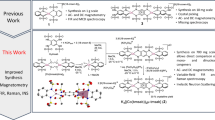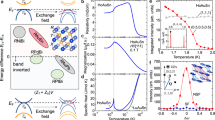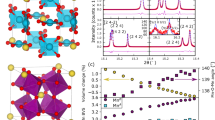Abstract
Freeman, Murray and Richards1, following a suggestion of Orgel, have confirmed that for first period ligands a linear relation exists between the nuclear resonance frequency νj and the wavelength λj of the 1T1g←1A1g absorption maximum of octahedrally coordinated cobalt (III) complexes  where γ is the magnetogyric ratio of the cobalt-59 nucleus and H0 is the external field (fixed to ±0.1 oersted at 12,575·6 oersted in the experiments described here). The diamagnetic contribution Aj to the shielding constant is expected to be largely independent of the ligand environment, for its magnitude is controlled by 〈rk−1〉 for 1s, 2s, 3s, 2p and 3p electrons: a reasonable estimate1 leads to Aj = 0.0021. A high degree of paramagnetic shielding B0/Δj arises from second order Zeeman effect paramagnetism. Crystal field calculations2,3 give
where γ is the magnetogyric ratio of the cobalt-59 nucleus and H0 is the external field (fixed to ±0.1 oersted at 12,575·6 oersted in the experiments described here). The diamagnetic contribution Aj to the shielding constant is expected to be largely independent of the ligand environment, for its magnitude is controlled by 〈rk−1〉 for 1s, 2s, 3s, 2p and 3p electrons: a reasonable estimate1 leads to Aj = 0.0021. A high degree of paramagnetic shielding B0/Δj arises from second order Zeeman effect paramagnetism. Crystal field calculations2,3 give  with 1/Δj being approximated by the wavelength in cm of the 1T1g←1A1g band. Griffith3 has noted that any deviation from pure 3d orbitals can be accommodated by introducing an orbital reduction factor kσπ (between t2g and eg orbitals), so that
with 1/Δj being approximated by the wavelength in cm of the 1T1g←1A1g band. Griffith3 has noted that any deviation from pure 3d orbitals can be accommodated by introducing an orbital reduction factor kσπ (between t2g and eg orbitals), so that  where β is the Bohr magneton. Accordingly, broad line 59Co NMR spectra should provide a sensitive probe for variations in either kσπ and/or r3d with the nature of the attached ligand.
where β is the Bohr magneton. Accordingly, broad line 59Co NMR spectra should provide a sensitive probe for variations in either kσπ and/or r3d with the nature of the attached ligand.
This is a preview of subscription content, access via your institution
Access options
Subscribe to this journal
Receive 51 print issues and online access
$199.00 per year
only $3.90 per issue
Buy this article
- Purchase on SpringerLink
- Instant access to full article PDF
Prices may be subject to local taxes which are calculated during checkout
Similar content being viewed by others
References
Freeman, R., Murray, G. R., and Richards, R. E., Proc. Roy. Soc., A,242, 455 (1957).
Griffith, J. S., and Orgel, L. E., Trans. Faraday Soc, 53, 601 (1957).
Griffith, J. S., The Theory of Transition-Metal Ions, 374 (Cambridge University Press, 1961).
Owen, J., and Thornley, J. H. M., Rep. Prog. Phys., 85, 675 (1967).
Kanekar, C. R., Dhingra, M. M., Marathe, V. R., and Nagarajan, R., J. Chem. Phys., 46, 2009 (1967).
Martin, R. L., and White, A. H., Transition Metal Chemistry (edit. by Carlin, R. L.), 4, 113 (Dekker, New York, 1968).
Author information
Authors and Affiliations
Rights and permissions
About this article
Cite this article
MARTIN, R., WHITE, A. Cobalt-59 Nuclear Magnetic Resonance of Sulphur, Selenium and Arsenic Chelates of Cobalt (III). Nature 223, 394–396 (1969). https://doi.org/10.1038/223394a0
Received:
Revised:
Issue date:
DOI: https://doi.org/10.1038/223394a0



